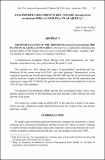Mostrar el registro sencillo del ítem
Analisis del crecimiento del tomate (Licopersicon esculentum Mill) ev. Catalina, en Alajuela
Growth analysis of the tomato (Licopersicon esculentum Mill) plant in Alajuela, Costa Rica
| dc.creator | Cerdas, Jean Carlos | |
| dc.creator | Moreira, Marco A. | |
| dc.date.accessioned | 2019-08-08T21:04:23Z | |
| dc.date.available | 2019-08-08T21:04:23Z | |
| dc.date.issued | 1990 | |
| dc.identifier.issn | 1011-8659 | |
| dc.identifier.uri | https://hdl.handle.net/10669/78719 | |
| dc.description.abstract | En el presente trabajo se determinó el patrón de crecimiento del tomate para mesa cv. Catalina, durante el ciclo de la planta en Alajuela. Costa Rica. Se utilizó un diseño de bloques completos al azar, con cuatro repeticiones. Se realizaron muestreos cada 15 días durante el ciclo de la planta. Durante la etapa de germinación, brotación y establecimiento del tomate (0-6 DDS), el crecimiento de la planta fue muy lento. Posteriormente en la etapa de desarrollo vegetativo y fructificación (60-90 DDS), la tasa de crecimiento aumentó y el peso seco total de la planta alcanzó el máximo valor. En la etapa de maduración y senescencia (90-135 DDS), el crecimiento disminuyó hasta llegar a estabilizarse entre los 120 y 135 días después de la siembra El Indice de Crecimiento Relativo (ICR) y el Indice de Asimilación Neta (IAN) se redujeron notablemente debido a la floración y la fructificación, que causó una disminución en el crecimiento total de la planta. El peso seco foliar constituyó alrededor del 50% del peso seco total de la planta. No existió una relación de peso equilibrada entre el peso seco radical y el peso seco aéreo. | es_ES |
| dc.description.abstract | The trial was conducted to determine the growth pattern of the tomato (Licopersicon esculentum Mill) plant, ‘Catalina’ cultivar, during its vegetative cycle, in Alajuela, Costa Rica. A Randomized Complete Block Design with four replications was used. Samples were taken every two weeks during the plant’s cycle. The growth was slow during the stages of germination, sprouting and stablishment of the tomato plant (0-6 DAP- days after planting). Subsequently, at the vegetative growth and fructification stages (60-90 DAP) the rate of growth increased and the total dry weigth of the plant reached its highest value. In the maturation and senescence stages (90-135 DAP), the growth rate diminished and stabilized between 120-135 days after planting. The Relative Growth Index (RGI) and the Net Assimilation Index (NAI) were greatly reduced because of the blooming and fruit bearing, which affected the total growth of the plant. The foliar dry weigth made up about 50% of the total dry weigth of the plant. There was not a balanced weight relation between the dry weigth of the root and the aerial dry weigth. | en_US |
| dc.format | application/pdf | |
| dc.language.iso | es | es_ES |
| dc.publisher | Universidad de Costa Rica | es-ES |
| dc.rights | Todos los derechos reservados 1990 | * |
| dc.source | Boletín Técnico, Vol 23(3), pp. 12-22 | es_ES |
| dc.title | Analisis del crecimiento del tomate (Licopersicon esculentum Mill) ev. Catalina, en Alajuela | es_ES |
| dc.title | Growth analysis of the tomato (Licopersicon esculentum Mill) plant in Alajuela, Costa Rica | en_US |
| dc.type | artículo original | |
| dc.description.procedence | UCR::Vicerrectoría de Investigación::Unidades de Investigación::Ciencias Agroalimentarias::Estación Experimental Agrícola Fabio Baudrit Moreno (EEAFBM) | es_ES |
Ficheros en el ítem
Este ítem aparece en la(s) siguiente(s) colección(ones)
-
Vol. 23 [9]


